Strategic Analysis of an Organization | Deal Study
VerifiedAdded on 2022/08/11
|18
|3850
|41
AI Summary
Contribute Materials
Your contribution can guide someone’s learning journey. Share your
documents today.
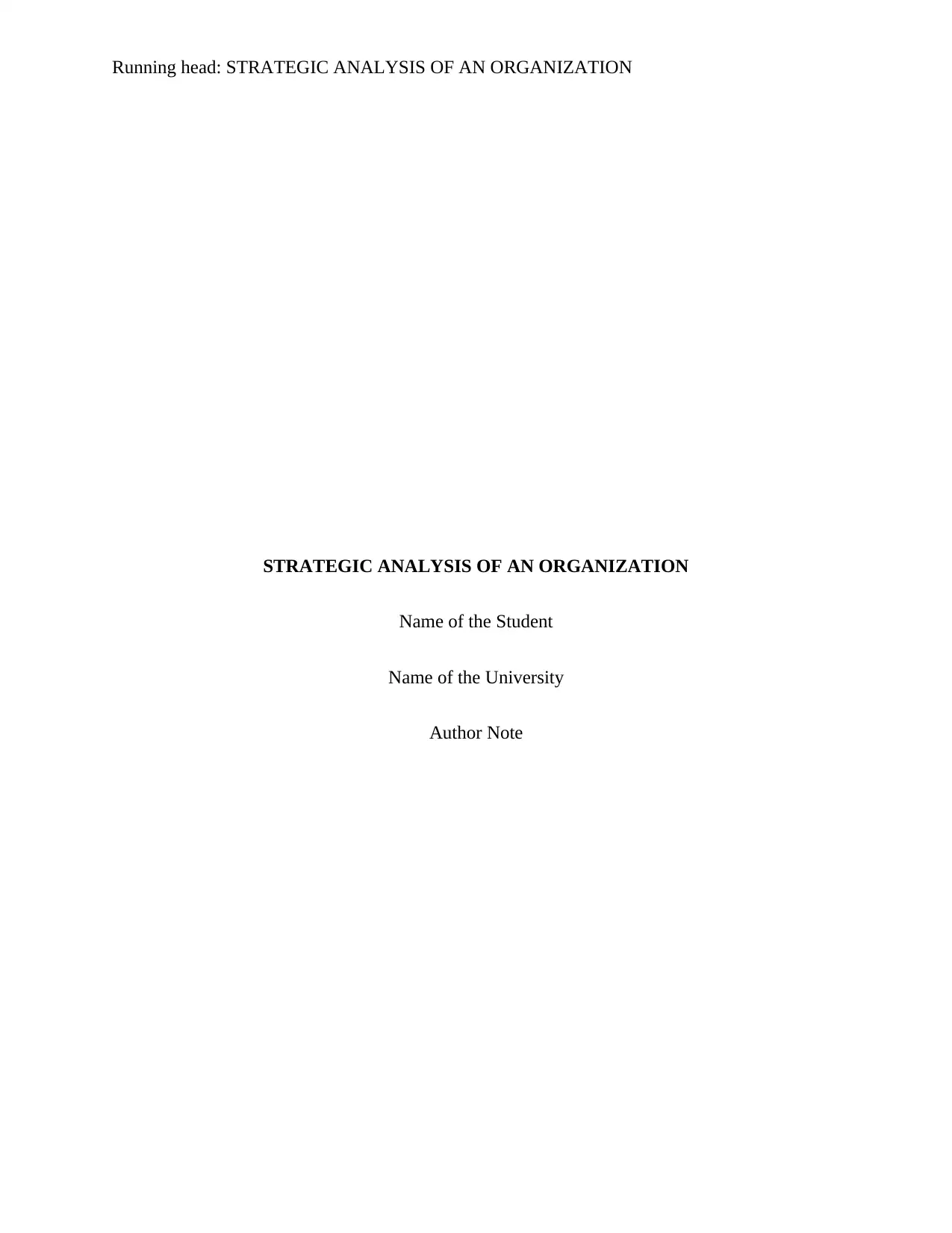
Running head: STRATEGIC ANALYSIS OF AN ORGANIZATION
STRATEGIC ANALYSIS OF AN ORGANIZATION
Name of the Student
Name of the University
Author Note
STRATEGIC ANALYSIS OF AN ORGANIZATION
Name of the Student
Name of the University
Author Note
Secure Best Marks with AI Grader
Need help grading? Try our AI Grader for instant feedback on your assignments.
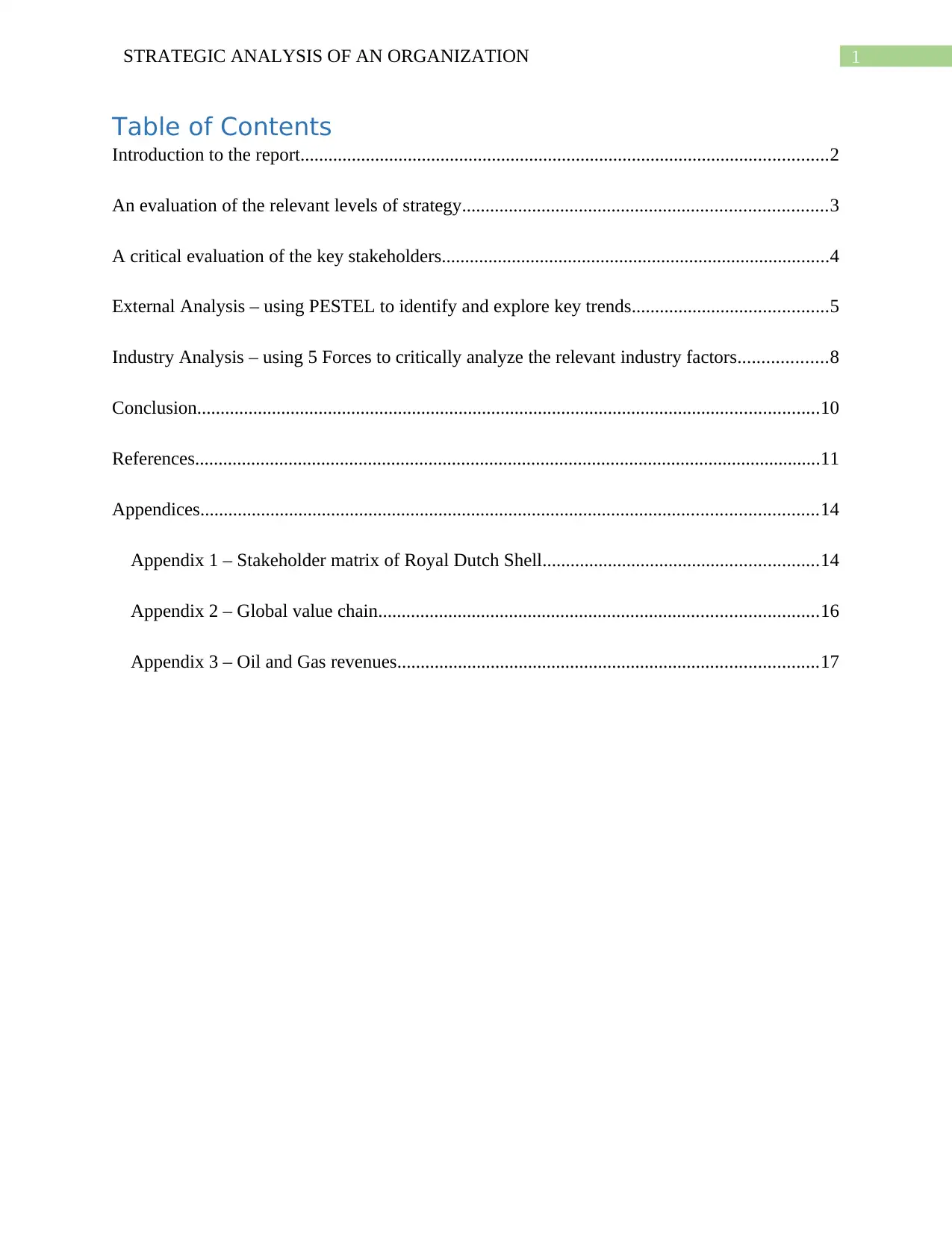
1STRATEGIC ANALYSIS OF AN ORGANIZATION
Table of Contents
Introduction to the report.................................................................................................................2
An evaluation of the relevant levels of strategy..............................................................................3
A critical evaluation of the key stakeholders...................................................................................4
External Analysis – using PESTEL to identify and explore key trends..........................................5
Industry Analysis – using 5 Forces to critically analyze the relevant industry factors...................8
Conclusion.....................................................................................................................................10
References......................................................................................................................................11
Appendices....................................................................................................................................14
Appendix 1 – Stakeholder matrix of Royal Dutch Shell...........................................................14
Appendix 2 – Global value chain..............................................................................................16
Appendix 3 – Oil and Gas revenues..........................................................................................17
Table of Contents
Introduction to the report.................................................................................................................2
An evaluation of the relevant levels of strategy..............................................................................3
A critical evaluation of the key stakeholders...................................................................................4
External Analysis – using PESTEL to identify and explore key trends..........................................5
Industry Analysis – using 5 Forces to critically analyze the relevant industry factors...................8
Conclusion.....................................................................................................................................10
References......................................................................................................................................11
Appendices....................................................................................................................................14
Appendix 1 – Stakeholder matrix of Royal Dutch Shell...........................................................14
Appendix 2 – Global value chain..............................................................................................16
Appendix 3 – Oil and Gas revenues..........................................................................................17
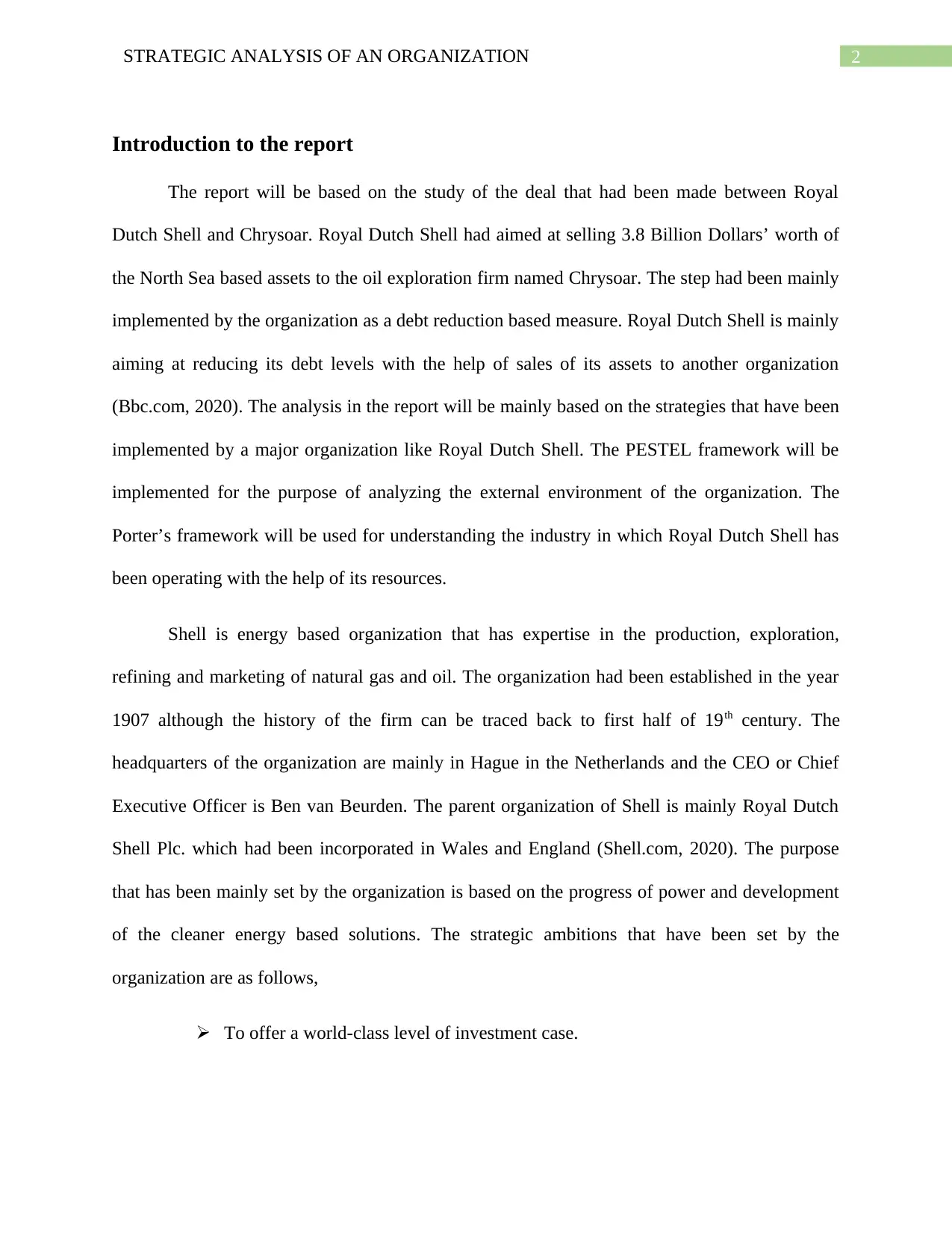
2STRATEGIC ANALYSIS OF AN ORGANIZATION
Introduction to the report
The report will be based on the study of the deal that had been made between Royal
Dutch Shell and Chrysoar. Royal Dutch Shell had aimed at selling 3.8 Billion Dollars’ worth of
the North Sea based assets to the oil exploration firm named Chrysoar. The step had been mainly
implemented by the organization as a debt reduction based measure. Royal Dutch Shell is mainly
aiming at reducing its debt levels with the help of sales of its assets to another organization
(Bbc.com, 2020). The analysis in the report will be mainly based on the strategies that have been
implemented by a major organization like Royal Dutch Shell. The PESTEL framework will be
implemented for the purpose of analyzing the external environment of the organization. The
Porter’s framework will be used for understanding the industry in which Royal Dutch Shell has
been operating with the help of its resources.
Shell is energy based organization that has expertise in the production, exploration,
refining and marketing of natural gas and oil. The organization had been established in the year
1907 although the history of the firm can be traced back to first half of 19th century. The
headquarters of the organization are mainly in Hague in the Netherlands and the CEO or Chief
Executive Officer is Ben van Beurden. The parent organization of Shell is mainly Royal Dutch
Shell Plc. which had been incorporated in Wales and England (Shell.com, 2020). The purpose
that has been mainly set by the organization is based on the progress of power and development
of the cleaner energy based solutions. The strategic ambitions that have been set by the
organization are as follows,
To offer a world-class level of investment case.
Introduction to the report
The report will be based on the study of the deal that had been made between Royal
Dutch Shell and Chrysoar. Royal Dutch Shell had aimed at selling 3.8 Billion Dollars’ worth of
the North Sea based assets to the oil exploration firm named Chrysoar. The step had been mainly
implemented by the organization as a debt reduction based measure. Royal Dutch Shell is mainly
aiming at reducing its debt levels with the help of sales of its assets to another organization
(Bbc.com, 2020). The analysis in the report will be mainly based on the strategies that have been
implemented by a major organization like Royal Dutch Shell. The PESTEL framework will be
implemented for the purpose of analyzing the external environment of the organization. The
Porter’s framework will be used for understanding the industry in which Royal Dutch Shell has
been operating with the help of its resources.
Shell is energy based organization that has expertise in the production, exploration,
refining and marketing of natural gas and oil. The organization had been established in the year
1907 although the history of the firm can be traced back to first half of 19th century. The
headquarters of the organization are mainly in Hague in the Netherlands and the CEO or Chief
Executive Officer is Ben van Beurden. The parent organization of Shell is mainly Royal Dutch
Shell Plc. which had been incorporated in Wales and England (Shell.com, 2020). The purpose
that has been mainly set by the organization is based on the progress of power and development
of the cleaner energy based solutions. The strategic ambitions that have been set by the
organization are as follows,
To offer a world-class level of investment case.
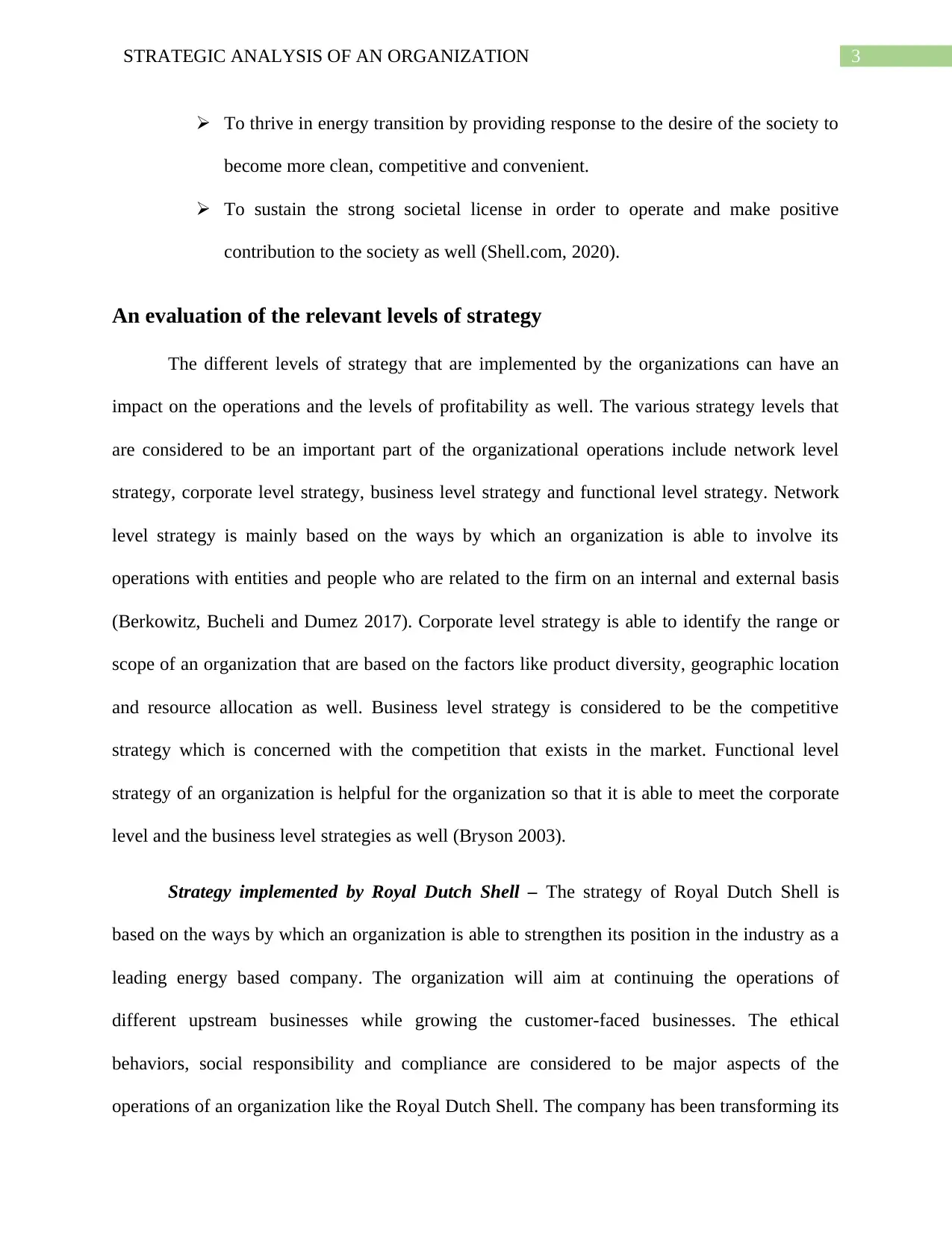
3STRATEGIC ANALYSIS OF AN ORGANIZATION
To thrive in energy transition by providing response to the desire of the society to
become more clean, competitive and convenient.
To sustain the strong societal license in order to operate and make positive
contribution to the society as well (Shell.com, 2020).
An evaluation of the relevant levels of strategy
The different levels of strategy that are implemented by the organizations can have an
impact on the operations and the levels of profitability as well. The various strategy levels that
are considered to be an important part of the organizational operations include network level
strategy, corporate level strategy, business level strategy and functional level strategy. Network
level strategy is mainly based on the ways by which an organization is able to involve its
operations with entities and people who are related to the firm on an internal and external basis
(Berkowitz, Bucheli and Dumez 2017). Corporate level strategy is able to identify the range or
scope of an organization that are based on the factors like product diversity, geographic location
and resource allocation as well. Business level strategy is considered to be the competitive
strategy which is concerned with the competition that exists in the market. Functional level
strategy of an organization is helpful for the organization so that it is able to meet the corporate
level and the business level strategies as well (Bryson 2003).
Strategy implemented by Royal Dutch Shell – The strategy of Royal Dutch Shell is
based on the ways by which an organization is able to strengthen its position in the industry as a
leading energy based company. The organization will aim at continuing the operations of
different upstream businesses while growing the customer-faced businesses. The ethical
behaviors, social responsibility and compliance are considered to be major aspects of the
operations of an organization like the Royal Dutch Shell. The company has been transforming its
To thrive in energy transition by providing response to the desire of the society to
become more clean, competitive and convenient.
To sustain the strong societal license in order to operate and make positive
contribution to the society as well (Shell.com, 2020).
An evaluation of the relevant levels of strategy
The different levels of strategy that are implemented by the organizations can have an
impact on the operations and the levels of profitability as well. The various strategy levels that
are considered to be an important part of the organizational operations include network level
strategy, corporate level strategy, business level strategy and functional level strategy. Network
level strategy is mainly based on the ways by which an organization is able to involve its
operations with entities and people who are related to the firm on an internal and external basis
(Berkowitz, Bucheli and Dumez 2017). Corporate level strategy is able to identify the range or
scope of an organization that are based on the factors like product diversity, geographic location
and resource allocation as well. Business level strategy is considered to be the competitive
strategy which is concerned with the competition that exists in the market. Functional level
strategy of an organization is helpful for the organization so that it is able to meet the corporate
level and the business level strategies as well (Bryson 2003).
Strategy implemented by Royal Dutch Shell – The strategy of Royal Dutch Shell is
based on the ways by which an organization is able to strengthen its position in the industry as a
leading energy based company. The organization will aim at continuing the operations of
different upstream businesses while growing the customer-faced businesses. The ethical
behaviors, social responsibility and compliance are considered to be major aspects of the
operations of an organization like the Royal Dutch Shell. The company has been transforming its
Secure Best Marks with AI Grader
Need help grading? Try our AI Grader for instant feedback on your assignments.
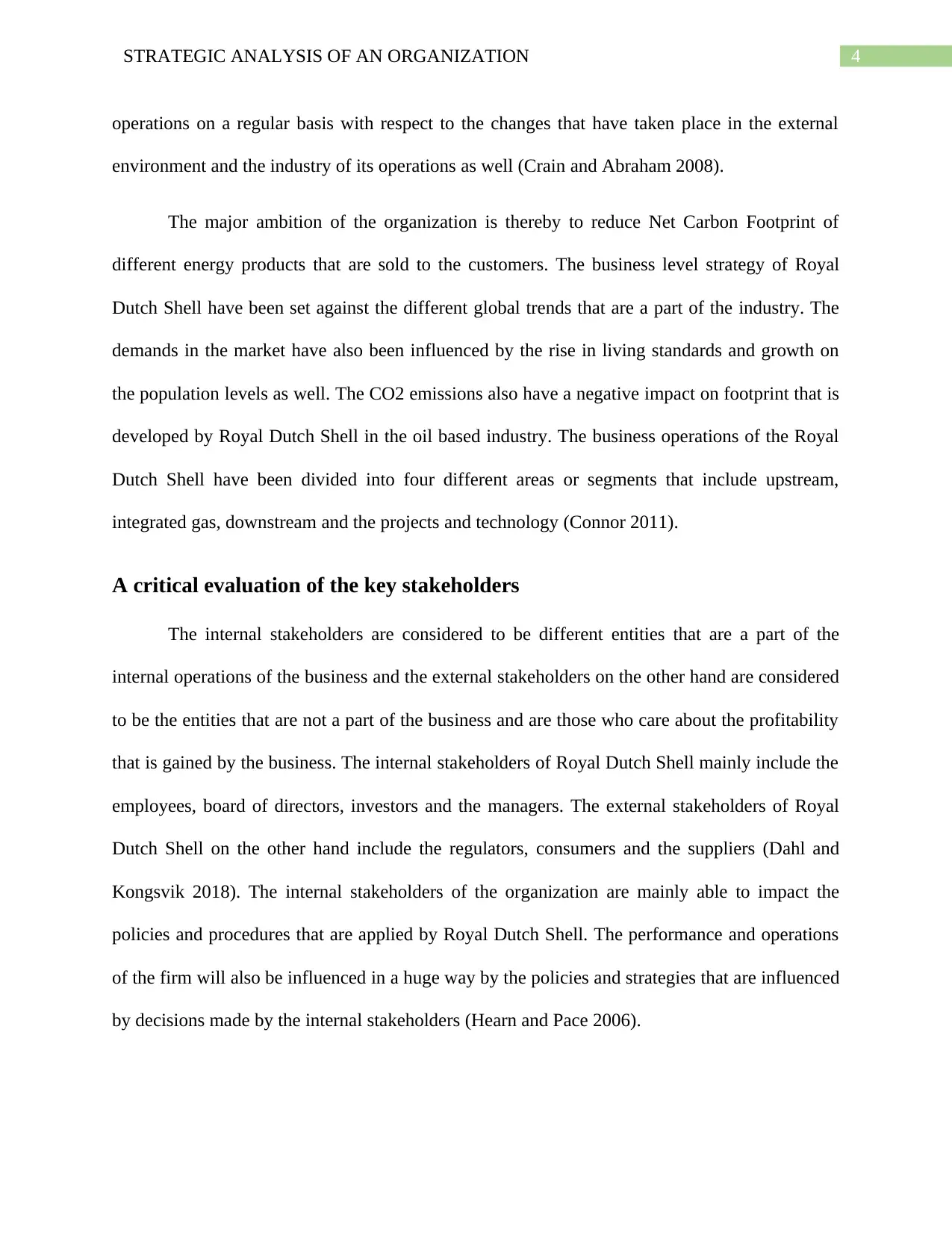
4STRATEGIC ANALYSIS OF AN ORGANIZATION
operations on a regular basis with respect to the changes that have taken place in the external
environment and the industry of its operations as well (Crain and Abraham 2008).
The major ambition of the organization is thereby to reduce Net Carbon Footprint of
different energy products that are sold to the customers. The business level strategy of Royal
Dutch Shell have been set against the different global trends that are a part of the industry. The
demands in the market have also been influenced by the rise in living standards and growth on
the population levels as well. The CO2 emissions also have a negative impact on footprint that is
developed by Royal Dutch Shell in the oil based industry. The business operations of the Royal
Dutch Shell have been divided into four different areas or segments that include upstream,
integrated gas, downstream and the projects and technology (Connor 2011).
A critical evaluation of the key stakeholders
The internal stakeholders are considered to be different entities that are a part of the
internal operations of the business and the external stakeholders on the other hand are considered
to be the entities that are not a part of the business and are those who care about the profitability
that is gained by the business. The internal stakeholders of Royal Dutch Shell mainly include the
employees, board of directors, investors and the managers. The external stakeholders of Royal
Dutch Shell on the other hand include the regulators, consumers and the suppliers (Dahl and
Kongsvik 2018). The internal stakeholders of the organization are mainly able to impact the
policies and procedures that are applied by Royal Dutch Shell. The performance and operations
of the firm will also be influenced in a huge way by the policies and strategies that are influenced
by decisions made by the internal stakeholders (Hearn and Pace 2006).
operations on a regular basis with respect to the changes that have taken place in the external
environment and the industry of its operations as well (Crain and Abraham 2008).
The major ambition of the organization is thereby to reduce Net Carbon Footprint of
different energy products that are sold to the customers. The business level strategy of Royal
Dutch Shell have been set against the different global trends that are a part of the industry. The
demands in the market have also been influenced by the rise in living standards and growth on
the population levels as well. The CO2 emissions also have a negative impact on footprint that is
developed by Royal Dutch Shell in the oil based industry. The business operations of the Royal
Dutch Shell have been divided into four different areas or segments that include upstream,
integrated gas, downstream and the projects and technology (Connor 2011).
A critical evaluation of the key stakeholders
The internal stakeholders are considered to be different entities that are a part of the
internal operations of the business and the external stakeholders on the other hand are considered
to be the entities that are not a part of the business and are those who care about the profitability
that is gained by the business. The internal stakeholders of Royal Dutch Shell mainly include the
employees, board of directors, investors and the managers. The external stakeholders of Royal
Dutch Shell on the other hand include the regulators, consumers and the suppliers (Dahl and
Kongsvik 2018). The internal stakeholders of the organization are mainly able to impact the
policies and procedures that are applied by Royal Dutch Shell. The performance and operations
of the firm will also be influenced in a huge way by the policies and strategies that are influenced
by decisions made by the internal stakeholders (Hearn and Pace 2006).
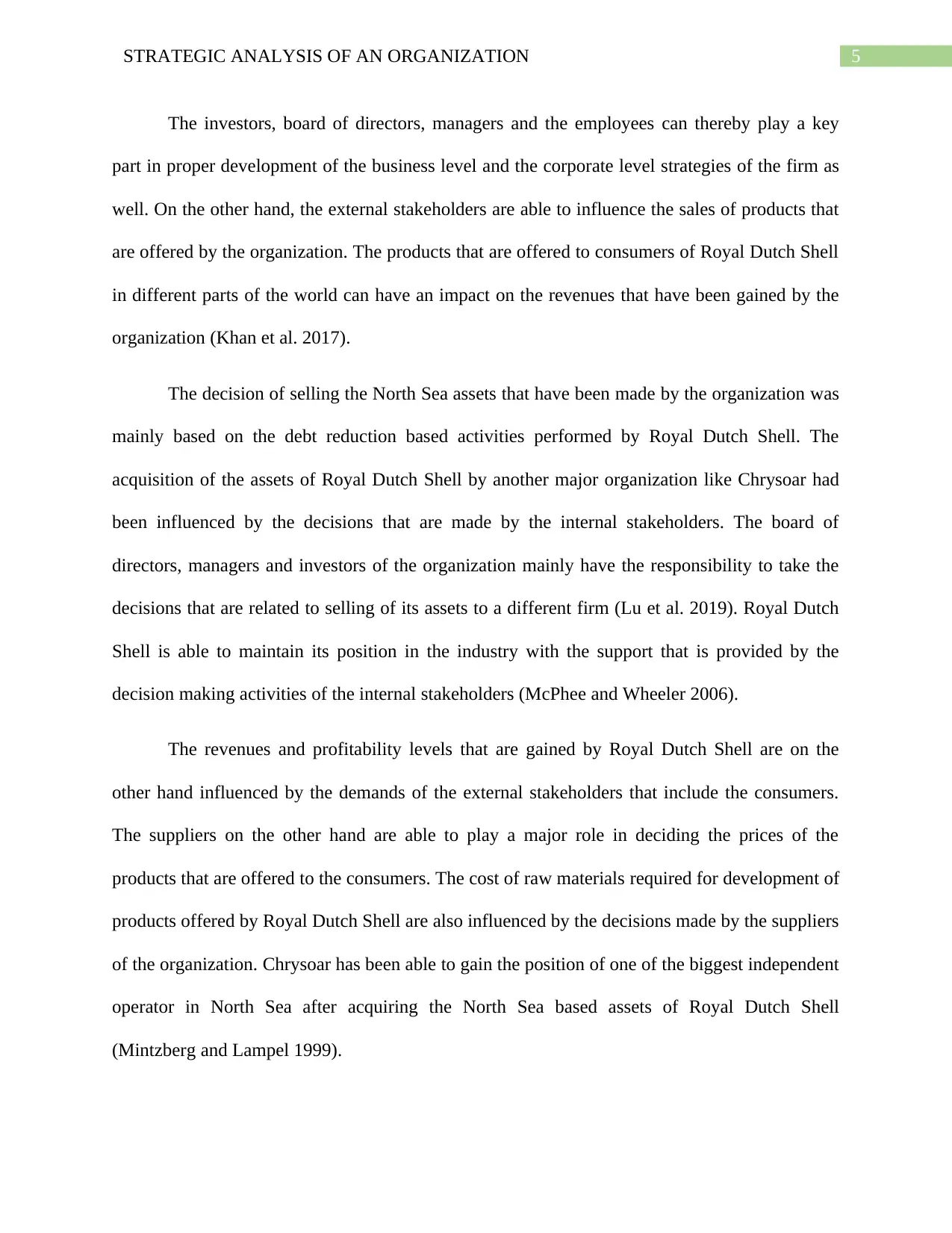
5STRATEGIC ANALYSIS OF AN ORGANIZATION
The investors, board of directors, managers and the employees can thereby play a key
part in proper development of the business level and the corporate level strategies of the firm as
well. On the other hand, the external stakeholders are able to influence the sales of products that
are offered by the organization. The products that are offered to consumers of Royal Dutch Shell
in different parts of the world can have an impact on the revenues that have been gained by the
organization (Khan et al. 2017).
The decision of selling the North Sea assets that have been made by the organization was
mainly based on the debt reduction based activities performed by Royal Dutch Shell. The
acquisition of the assets of Royal Dutch Shell by another major organization like Chrysoar had
been influenced by the decisions that are made by the internal stakeholders. The board of
directors, managers and investors of the organization mainly have the responsibility to take the
decisions that are related to selling of its assets to a different firm (Lu et al. 2019). Royal Dutch
Shell is able to maintain its position in the industry with the support that is provided by the
decision making activities of the internal stakeholders (McPhee and Wheeler 2006).
The revenues and profitability levels that are gained by Royal Dutch Shell are on the
other hand influenced by the demands of the external stakeholders that include the consumers.
The suppliers on the other hand are able to play a major role in deciding the prices of the
products that are offered to the consumers. The cost of raw materials required for development of
products offered by Royal Dutch Shell are also influenced by the decisions made by the suppliers
of the organization. Chrysoar has been able to gain the position of one of the biggest independent
operator in North Sea after acquiring the North Sea based assets of Royal Dutch Shell
(Mintzberg and Lampel 1999).
The investors, board of directors, managers and the employees can thereby play a key
part in proper development of the business level and the corporate level strategies of the firm as
well. On the other hand, the external stakeholders are able to influence the sales of products that
are offered by the organization. The products that are offered to consumers of Royal Dutch Shell
in different parts of the world can have an impact on the revenues that have been gained by the
organization (Khan et al. 2017).
The decision of selling the North Sea assets that have been made by the organization was
mainly based on the debt reduction based activities performed by Royal Dutch Shell. The
acquisition of the assets of Royal Dutch Shell by another major organization like Chrysoar had
been influenced by the decisions that are made by the internal stakeholders. The board of
directors, managers and investors of the organization mainly have the responsibility to take the
decisions that are related to selling of its assets to a different firm (Lu et al. 2019). Royal Dutch
Shell is able to maintain its position in the industry with the support that is provided by the
decision making activities of the internal stakeholders (McPhee and Wheeler 2006).
The revenues and profitability levels that are gained by Royal Dutch Shell are on the
other hand influenced by the demands of the external stakeholders that include the consumers.
The suppliers on the other hand are able to play a major role in deciding the prices of the
products that are offered to the consumers. The cost of raw materials required for development of
products offered by Royal Dutch Shell are also influenced by the decisions made by the suppliers
of the organization. Chrysoar has been able to gain the position of one of the biggest independent
operator in North Sea after acquiring the North Sea based assets of Royal Dutch Shell
(Mintzberg and Lampel 1999).
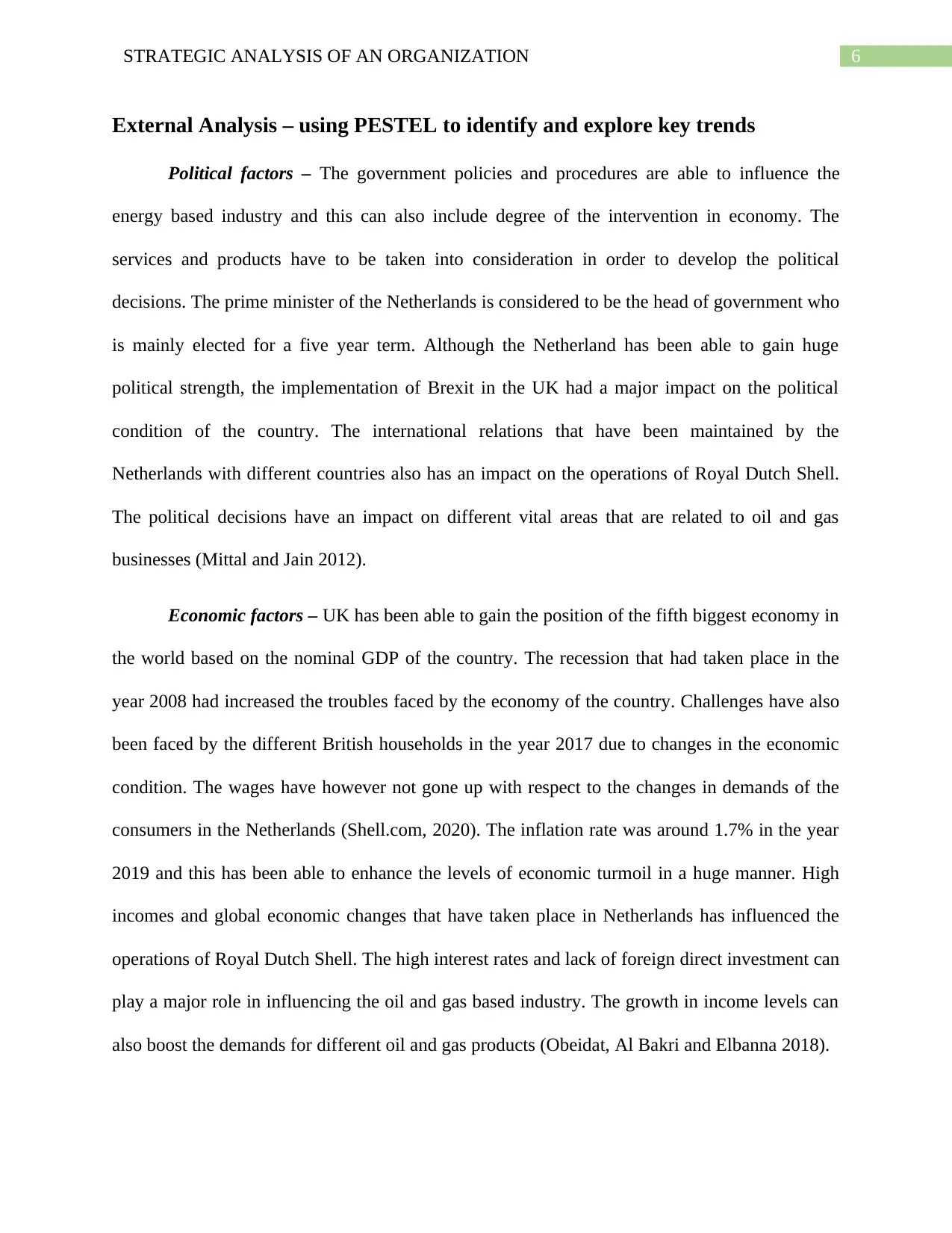
6STRATEGIC ANALYSIS OF AN ORGANIZATION
External Analysis – using PESTEL to identify and explore key trends
Political factors – The government policies and procedures are able to influence the
energy based industry and this can also include degree of the intervention in economy. The
services and products have to be taken into consideration in order to develop the political
decisions. The prime minister of the Netherlands is considered to be the head of government who
is mainly elected for a five year term. Although the Netherland has been able to gain huge
political strength, the implementation of Brexit in the UK had a major impact on the political
condition of the country. The international relations that have been maintained by the
Netherlands with different countries also has an impact on the operations of Royal Dutch Shell.
The political decisions have an impact on different vital areas that are related to oil and gas
businesses (Mittal and Jain 2012).
Economic factors – UK has been able to gain the position of the fifth biggest economy in
the world based on the nominal GDP of the country. The recession that had taken place in the
year 2008 had increased the troubles faced by the economy of the country. Challenges have also
been faced by the different British households in the year 2017 due to changes in the economic
condition. The wages have however not gone up with respect to the changes in demands of the
consumers in the Netherlands (Shell.com, 2020). The inflation rate was around 1.7% in the year
2019 and this has been able to enhance the levels of economic turmoil in a huge manner. High
incomes and global economic changes that have taken place in Netherlands has influenced the
operations of Royal Dutch Shell. The high interest rates and lack of foreign direct investment can
play a major role in influencing the oil and gas based industry. The growth in income levels can
also boost the demands for different oil and gas products (Obeidat, Al Bakri and Elbanna 2018).
External Analysis – using PESTEL to identify and explore key trends
Political factors – The government policies and procedures are able to influence the
energy based industry and this can also include degree of the intervention in economy. The
services and products have to be taken into consideration in order to develop the political
decisions. The prime minister of the Netherlands is considered to be the head of government who
is mainly elected for a five year term. Although the Netherland has been able to gain huge
political strength, the implementation of Brexit in the UK had a major impact on the political
condition of the country. The international relations that have been maintained by the
Netherlands with different countries also has an impact on the operations of Royal Dutch Shell.
The political decisions have an impact on different vital areas that are related to oil and gas
businesses (Mittal and Jain 2012).
Economic factors – UK has been able to gain the position of the fifth biggest economy in
the world based on the nominal GDP of the country. The recession that had taken place in the
year 2008 had increased the troubles faced by the economy of the country. Challenges have also
been faced by the different British households in the year 2017 due to changes in the economic
condition. The wages have however not gone up with respect to the changes in demands of the
consumers in the Netherlands (Shell.com, 2020). The inflation rate was around 1.7% in the year
2019 and this has been able to enhance the levels of economic turmoil in a huge manner. High
incomes and global economic changes that have taken place in Netherlands has influenced the
operations of Royal Dutch Shell. The high interest rates and lack of foreign direct investment can
play a major role in influencing the oil and gas based industry. The growth in income levels can
also boost the demands for different oil and gas products (Obeidat, Al Bakri and Elbanna 2018).
Paraphrase This Document
Need a fresh take? Get an instant paraphrase of this document with our AI Paraphraser
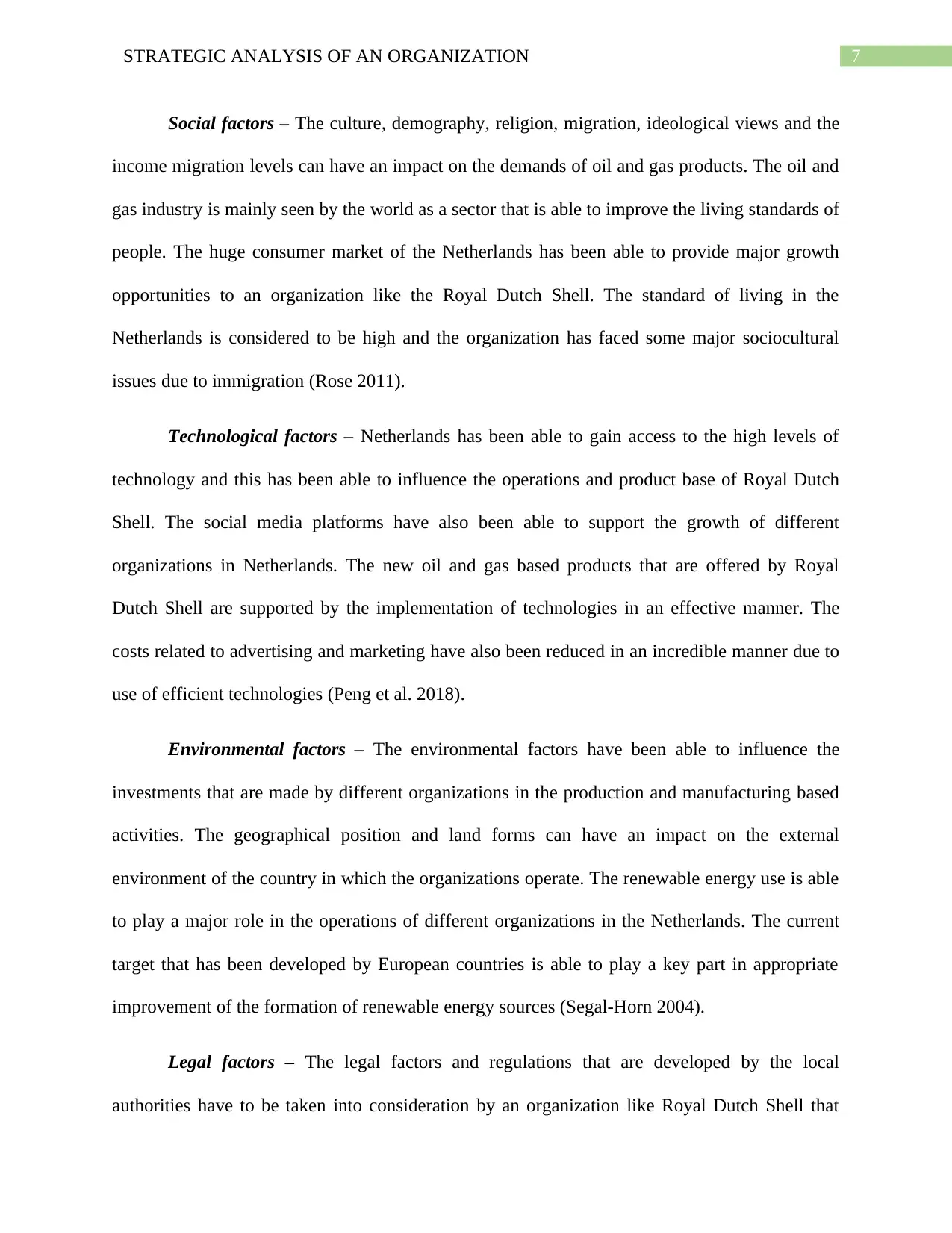
7STRATEGIC ANALYSIS OF AN ORGANIZATION
Social factors – The culture, demography, religion, migration, ideological views and the
income migration levels can have an impact on the demands of oil and gas products. The oil and
gas industry is mainly seen by the world as a sector that is able to improve the living standards of
people. The huge consumer market of the Netherlands has been able to provide major growth
opportunities to an organization like the Royal Dutch Shell. The standard of living in the
Netherlands is considered to be high and the organization has faced some major sociocultural
issues due to immigration (Rose 2011).
Technological factors – Netherlands has been able to gain access to the high levels of
technology and this has been able to influence the operations and product base of Royal Dutch
Shell. The social media platforms have also been able to support the growth of different
organizations in Netherlands. The new oil and gas based products that are offered by Royal
Dutch Shell are supported by the implementation of technologies in an effective manner. The
costs related to advertising and marketing have also been reduced in an incredible manner due to
use of efficient technologies (Peng et al. 2018).
Environmental factors – The environmental factors have been able to influence the
investments that are made by different organizations in the production and manufacturing based
activities. The geographical position and land forms can have an impact on the external
environment of the country in which the organizations operate. The renewable energy use is able
to play a major role in the operations of different organizations in the Netherlands. The current
target that has been developed by European countries is able to play a key part in appropriate
improvement of the formation of renewable energy sources (Segal-Horn 2004).
Legal factors – The legal factors and regulations that are developed by the local
authorities have to be taken into consideration by an organization like Royal Dutch Shell that
Social factors – The culture, demography, religion, migration, ideological views and the
income migration levels can have an impact on the demands of oil and gas products. The oil and
gas industry is mainly seen by the world as a sector that is able to improve the living standards of
people. The huge consumer market of the Netherlands has been able to provide major growth
opportunities to an organization like the Royal Dutch Shell. The standard of living in the
Netherlands is considered to be high and the organization has faced some major sociocultural
issues due to immigration (Rose 2011).
Technological factors – Netherlands has been able to gain access to the high levels of
technology and this has been able to influence the operations and product base of Royal Dutch
Shell. The social media platforms have also been able to support the growth of different
organizations in Netherlands. The new oil and gas based products that are offered by Royal
Dutch Shell are supported by the implementation of technologies in an effective manner. The
costs related to advertising and marketing have also been reduced in an incredible manner due to
use of efficient technologies (Peng et al. 2018).
Environmental factors – The environmental factors have been able to influence the
investments that are made by different organizations in the production and manufacturing based
activities. The geographical position and land forms can have an impact on the external
environment of the country in which the organizations operate. The renewable energy use is able
to play a major role in the operations of different organizations in the Netherlands. The current
target that has been developed by European countries is able to play a key part in appropriate
improvement of the formation of renewable energy sources (Segal-Horn 2004).
Legal factors – The legal factors and regulations that are developed by the local
authorities have to be taken into consideration by an organization like Royal Dutch Shell that
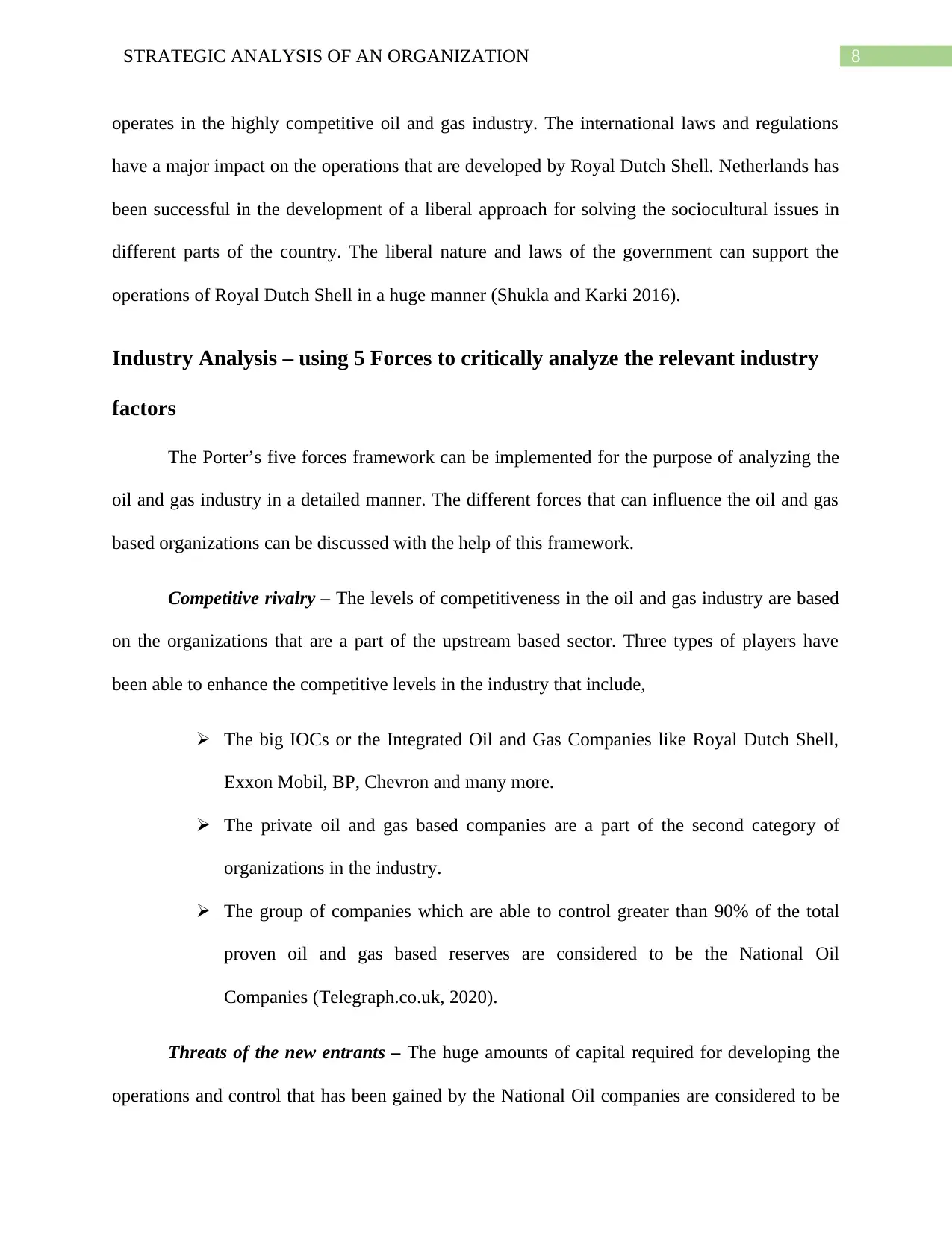
8STRATEGIC ANALYSIS OF AN ORGANIZATION
operates in the highly competitive oil and gas industry. The international laws and regulations
have a major impact on the operations that are developed by Royal Dutch Shell. Netherlands has
been successful in the development of a liberal approach for solving the sociocultural issues in
different parts of the country. The liberal nature and laws of the government can support the
operations of Royal Dutch Shell in a huge manner (Shukla and Karki 2016).
Industry Analysis – using 5 Forces to critically analyze the relevant industry
factors
The Porter’s five forces framework can be implemented for the purpose of analyzing the
oil and gas industry in a detailed manner. The different forces that can influence the oil and gas
based organizations can be discussed with the help of this framework.
Competitive rivalry – The levels of competitiveness in the oil and gas industry are based
on the organizations that are a part of the upstream based sector. Three types of players have
been able to enhance the competitive levels in the industry that include,
The big IOCs or the Integrated Oil and Gas Companies like Royal Dutch Shell,
Exxon Mobil, BP, Chevron and many more.
The private oil and gas based companies are a part of the second category of
organizations in the industry.
The group of companies which are able to control greater than 90% of the total
proven oil and gas based reserves are considered to be the National Oil
Companies (Telegraph.co.uk, 2020).
Threats of the new entrants – The huge amounts of capital required for developing the
operations and control that has been gained by the National Oil companies are considered to be
operates in the highly competitive oil and gas industry. The international laws and regulations
have a major impact on the operations that are developed by Royal Dutch Shell. Netherlands has
been successful in the development of a liberal approach for solving the sociocultural issues in
different parts of the country. The liberal nature and laws of the government can support the
operations of Royal Dutch Shell in a huge manner (Shukla and Karki 2016).
Industry Analysis – using 5 Forces to critically analyze the relevant industry
factors
The Porter’s five forces framework can be implemented for the purpose of analyzing the
oil and gas industry in a detailed manner. The different forces that can influence the oil and gas
based organizations can be discussed with the help of this framework.
Competitive rivalry – The levels of competitiveness in the oil and gas industry are based
on the organizations that are a part of the upstream based sector. Three types of players have
been able to enhance the competitive levels in the industry that include,
The big IOCs or the Integrated Oil and Gas Companies like Royal Dutch Shell,
Exxon Mobil, BP, Chevron and many more.
The private oil and gas based companies are a part of the second category of
organizations in the industry.
The group of companies which are able to control greater than 90% of the total
proven oil and gas based reserves are considered to be the National Oil
Companies (Telegraph.co.uk, 2020).
Threats of the new entrants – The huge amounts of capital required for developing the
operations and control that has been gained by the National Oil companies are considered to be
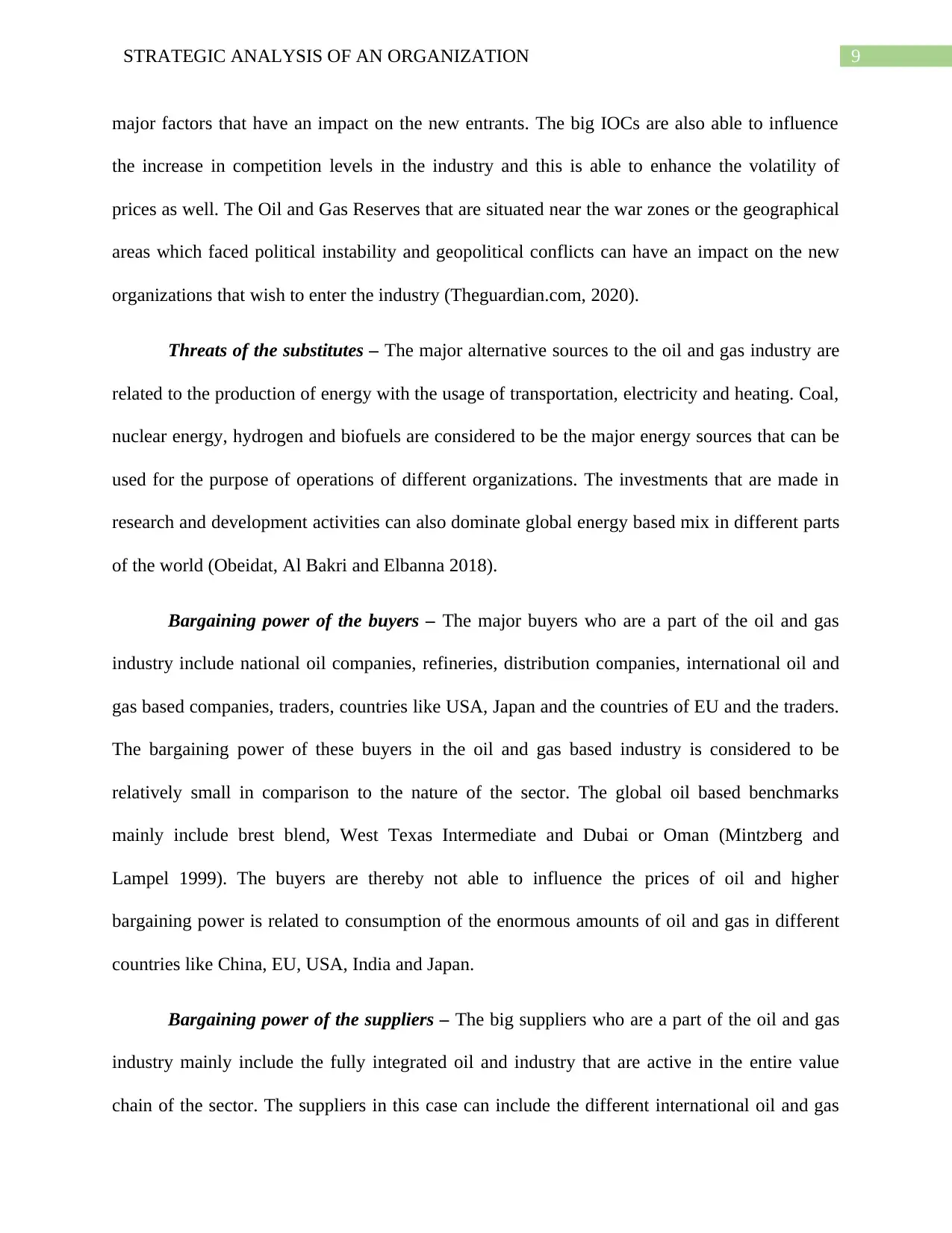
9STRATEGIC ANALYSIS OF AN ORGANIZATION
major factors that have an impact on the new entrants. The big IOCs are also able to influence
the increase in competition levels in the industry and this is able to enhance the volatility of
prices as well. The Oil and Gas Reserves that are situated near the war zones or the geographical
areas which faced political instability and geopolitical conflicts can have an impact on the new
organizations that wish to enter the industry (Theguardian.com, 2020).
Threats of the substitutes – The major alternative sources to the oil and gas industry are
related to the production of energy with the usage of transportation, electricity and heating. Coal,
nuclear energy, hydrogen and biofuels are considered to be the major energy sources that can be
used for the purpose of operations of different organizations. The investments that are made in
research and development activities can also dominate global energy based mix in different parts
of the world (Obeidat, Al Bakri and Elbanna 2018).
Bargaining power of the buyers – The major buyers who are a part of the oil and gas
industry include national oil companies, refineries, distribution companies, international oil and
gas based companies, traders, countries like USA, Japan and the countries of EU and the traders.
The bargaining power of these buyers in the oil and gas based industry is considered to be
relatively small in comparison to the nature of the sector. The global oil based benchmarks
mainly include brest blend, West Texas Intermediate and Dubai or Oman (Mintzberg and
Lampel 1999). The buyers are thereby not able to influence the prices of oil and higher
bargaining power is related to consumption of the enormous amounts of oil and gas in different
countries like China, EU, USA, India and Japan.
Bargaining power of the suppliers – The big suppliers who are a part of the oil and gas
industry mainly include the fully integrated oil and industry that are active in the entire value
chain of the sector. The suppliers in this case can include the different international oil and gas
major factors that have an impact on the new entrants. The big IOCs are also able to influence
the increase in competition levels in the industry and this is able to enhance the volatility of
prices as well. The Oil and Gas Reserves that are situated near the war zones or the geographical
areas which faced political instability and geopolitical conflicts can have an impact on the new
organizations that wish to enter the industry (Theguardian.com, 2020).
Threats of the substitutes – The major alternative sources to the oil and gas industry are
related to the production of energy with the usage of transportation, electricity and heating. Coal,
nuclear energy, hydrogen and biofuels are considered to be the major energy sources that can be
used for the purpose of operations of different organizations. The investments that are made in
research and development activities can also dominate global energy based mix in different parts
of the world (Obeidat, Al Bakri and Elbanna 2018).
Bargaining power of the buyers – The major buyers who are a part of the oil and gas
industry include national oil companies, refineries, distribution companies, international oil and
gas based companies, traders, countries like USA, Japan and the countries of EU and the traders.
The bargaining power of these buyers in the oil and gas based industry is considered to be
relatively small in comparison to the nature of the sector. The global oil based benchmarks
mainly include brest blend, West Texas Intermediate and Dubai or Oman (Mintzberg and
Lampel 1999). The buyers are thereby not able to influence the prices of oil and higher
bargaining power is related to consumption of the enormous amounts of oil and gas in different
countries like China, EU, USA, India and Japan.
Bargaining power of the suppliers – The big suppliers who are a part of the oil and gas
industry mainly include the fully integrated oil and industry that are active in the entire value
chain of the sector. The suppliers in this case can include the different international oil and gas
Secure Best Marks with AI Grader
Need help grading? Try our AI Grader for instant feedback on your assignments.
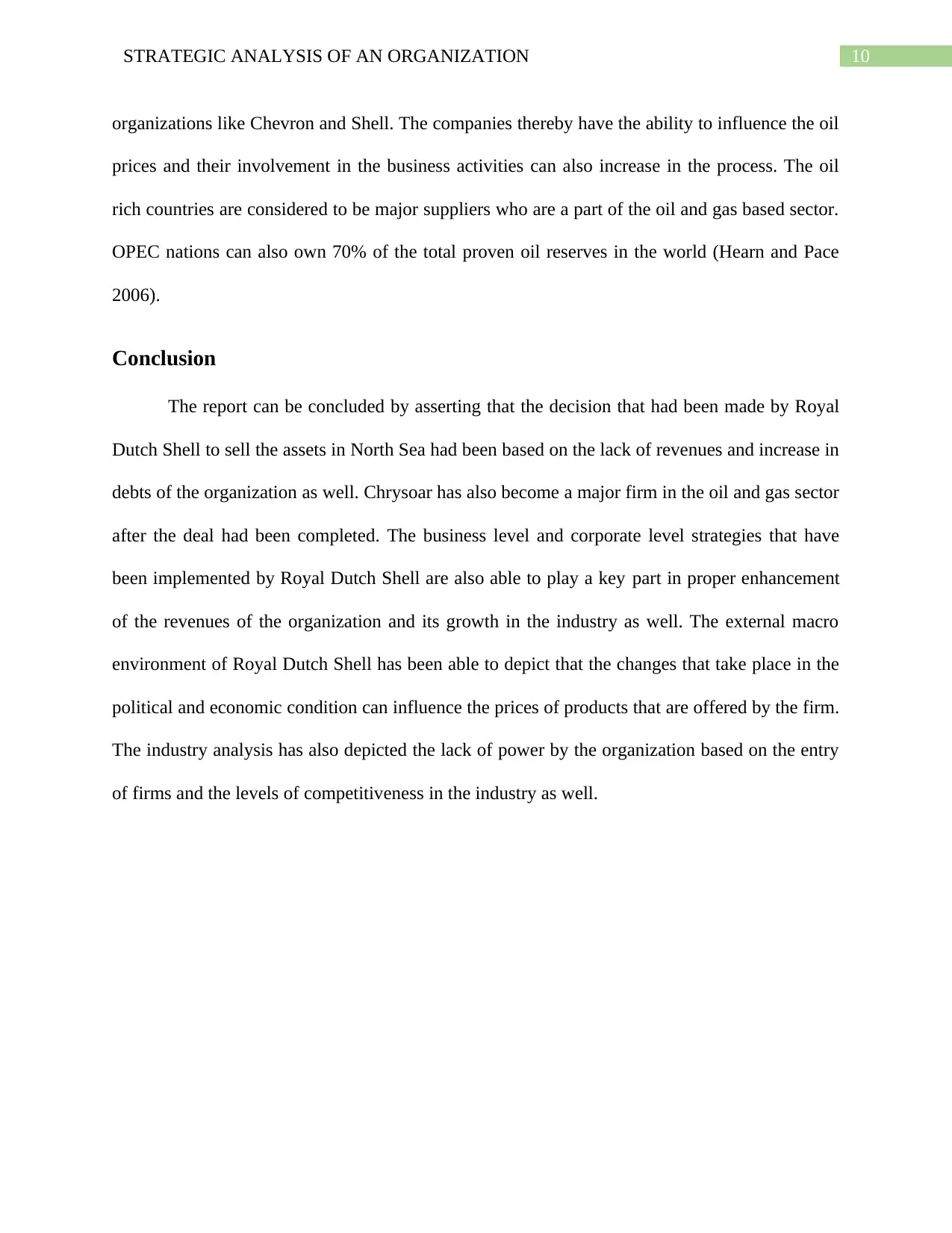
10STRATEGIC ANALYSIS OF AN ORGANIZATION
organizations like Chevron and Shell. The companies thereby have the ability to influence the oil
prices and their involvement in the business activities can also increase in the process. The oil
rich countries are considered to be major suppliers who are a part of the oil and gas based sector.
OPEC nations can also own 70% of the total proven oil reserves in the world (Hearn and Pace
2006).
Conclusion
The report can be concluded by asserting that the decision that had been made by Royal
Dutch Shell to sell the assets in North Sea had been based on the lack of revenues and increase in
debts of the organization as well. Chrysoar has also become a major firm in the oil and gas sector
after the deal had been completed. The business level and corporate level strategies that have
been implemented by Royal Dutch Shell are also able to play a key part in proper enhancement
of the revenues of the organization and its growth in the industry as well. The external macro
environment of Royal Dutch Shell has been able to depict that the changes that take place in the
political and economic condition can influence the prices of products that are offered by the firm.
The industry analysis has also depicted the lack of power by the organization based on the entry
of firms and the levels of competitiveness in the industry as well.
organizations like Chevron and Shell. The companies thereby have the ability to influence the oil
prices and their involvement in the business activities can also increase in the process. The oil
rich countries are considered to be major suppliers who are a part of the oil and gas based sector.
OPEC nations can also own 70% of the total proven oil reserves in the world (Hearn and Pace
2006).
Conclusion
The report can be concluded by asserting that the decision that had been made by Royal
Dutch Shell to sell the assets in North Sea had been based on the lack of revenues and increase in
debts of the organization as well. Chrysoar has also become a major firm in the oil and gas sector
after the deal had been completed. The business level and corporate level strategies that have
been implemented by Royal Dutch Shell are also able to play a key part in proper enhancement
of the revenues of the organization and its growth in the industry as well. The external macro
environment of Royal Dutch Shell has been able to depict that the changes that take place in the
political and economic condition can influence the prices of products that are offered by the firm.
The industry analysis has also depicted the lack of power by the organization based on the entry
of firms and the levels of competitiveness in the industry as well.
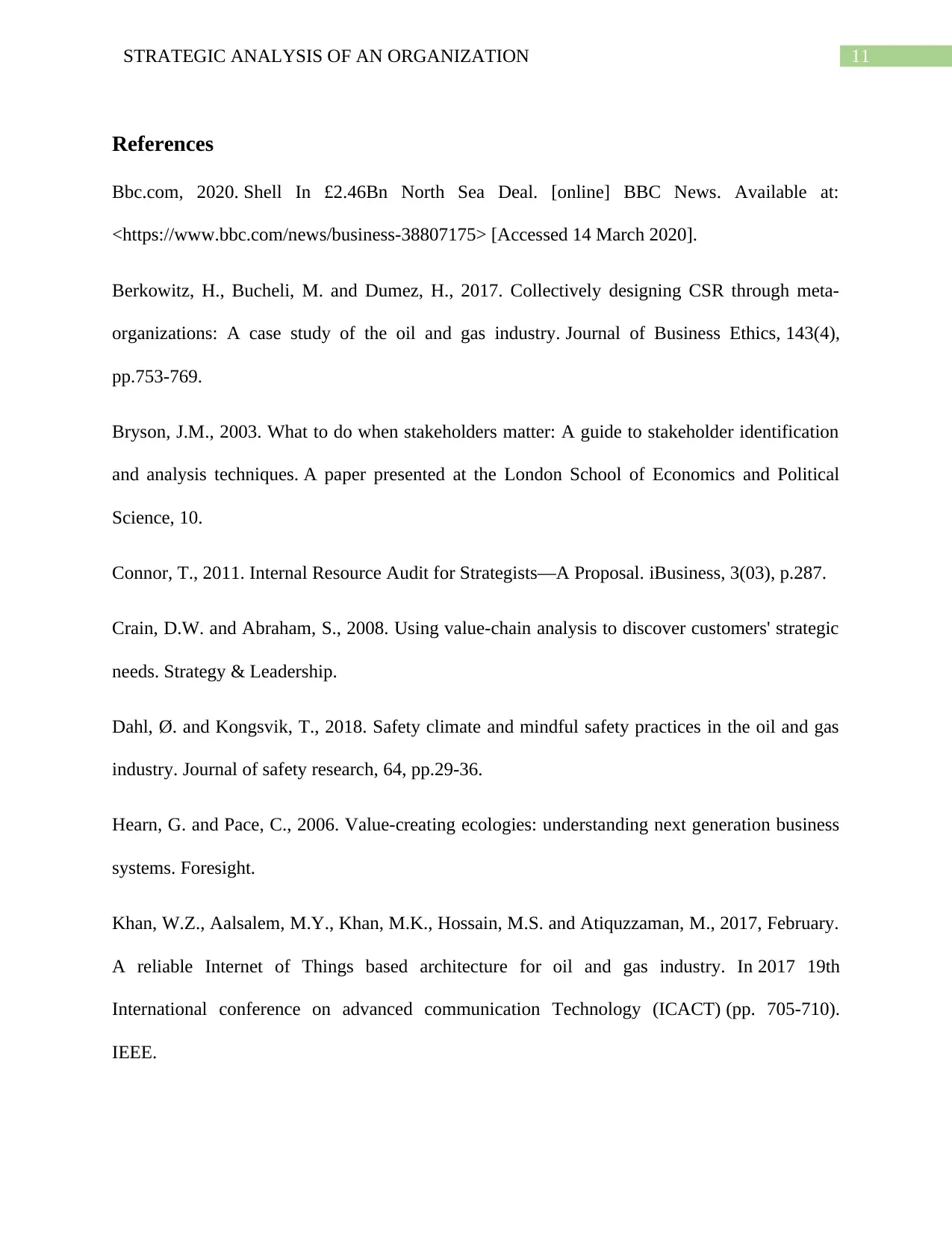
11STRATEGIC ANALYSIS OF AN ORGANIZATION
References
Bbc.com, 2020. Shell In £2.46Bn North Sea Deal. [online] BBC News. Available at:
<https://www.bbc.com/news/business-38807175> [Accessed 14 March 2020].
Berkowitz, H., Bucheli, M. and Dumez, H., 2017. Collectively designing CSR through meta-
organizations: A case study of the oil and gas industry. Journal of Business Ethics, 143(4),
pp.753-769.
Bryson, J.M., 2003. What to do when stakeholders matter: A guide to stakeholder identification
and analysis techniques. A paper presented at the London School of Economics and Political
Science, 10.
Connor, T., 2011. Internal Resource Audit for Strategists—A Proposal. iBusiness, 3(03), p.287.
Crain, D.W. and Abraham, S., 2008. Using value‐chain analysis to discover customers' strategic
needs. Strategy & Leadership.
Dahl, Ø. and Kongsvik, T., 2018. Safety climate and mindful safety practices in the oil and gas
industry. Journal of safety research, 64, pp.29-36.
Hearn, G. and Pace, C., 2006. Value‐creating ecologies: understanding next generation business
systems. Foresight.
Khan, W.Z., Aalsalem, M.Y., Khan, M.K., Hossain, M.S. and Atiquzzaman, M., 2017, February.
A reliable Internet of Things based architecture for oil and gas industry. In 2017 19th
International conference on advanced communication Technology (ICACT) (pp. 705-710).
IEEE.
References
Bbc.com, 2020. Shell In £2.46Bn North Sea Deal. [online] BBC News. Available at:
<https://www.bbc.com/news/business-38807175> [Accessed 14 March 2020].
Berkowitz, H., Bucheli, M. and Dumez, H., 2017. Collectively designing CSR through meta-
organizations: A case study of the oil and gas industry. Journal of Business Ethics, 143(4),
pp.753-769.
Bryson, J.M., 2003. What to do when stakeholders matter: A guide to stakeholder identification
and analysis techniques. A paper presented at the London School of Economics and Political
Science, 10.
Connor, T., 2011. Internal Resource Audit for Strategists—A Proposal. iBusiness, 3(03), p.287.
Crain, D.W. and Abraham, S., 2008. Using value‐chain analysis to discover customers' strategic
needs. Strategy & Leadership.
Dahl, Ø. and Kongsvik, T., 2018. Safety climate and mindful safety practices in the oil and gas
industry. Journal of safety research, 64, pp.29-36.
Hearn, G. and Pace, C., 2006. Value‐creating ecologies: understanding next generation business
systems. Foresight.
Khan, W.Z., Aalsalem, M.Y., Khan, M.K., Hossain, M.S. and Atiquzzaman, M., 2017, February.
A reliable Internet of Things based architecture for oil and gas industry. In 2017 19th
International conference on advanced communication Technology (ICACT) (pp. 705-710).
IEEE.
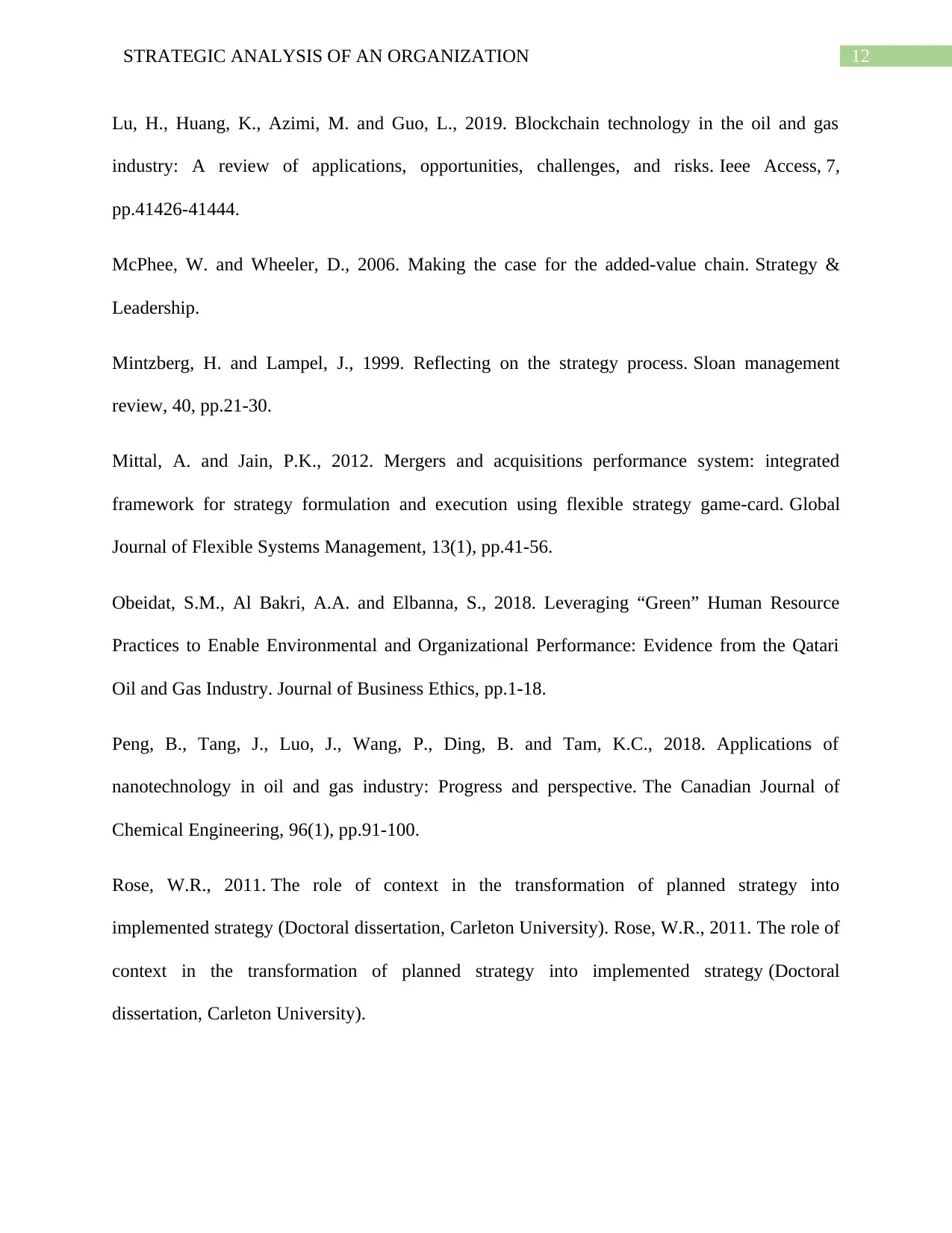
12STRATEGIC ANALYSIS OF AN ORGANIZATION
Lu, H., Huang, K., Azimi, M. and Guo, L., 2019. Blockchain technology in the oil and gas
industry: A review of applications, opportunities, challenges, and risks. Ieee Access, 7,
pp.41426-41444.
McPhee, W. and Wheeler, D., 2006. Making the case for the added‐value chain. Strategy &
Leadership.
Mintzberg, H. and Lampel, J., 1999. Reflecting on the strategy process. Sloan management
review, 40, pp.21-30.
Mittal, A. and Jain, P.K., 2012. Mergers and acquisitions performance system: integrated
framework for strategy formulation and execution using flexible strategy game-card. Global
Journal of Flexible Systems Management, 13(1), pp.41-56.
Obeidat, S.M., Al Bakri, A.A. and Elbanna, S., 2018. Leveraging “Green” Human Resource
Practices to Enable Environmental and Organizational Performance: Evidence from the Qatari
Oil and Gas Industry. Journal of Business Ethics, pp.1-18.
Peng, B., Tang, J., Luo, J., Wang, P., Ding, B. and Tam, K.C., 2018. Applications of
nanotechnology in oil and gas industry: Progress and perspective. The Canadian Journal of
Chemical Engineering, 96(1), pp.91-100.
Rose, W.R., 2011. The role of context in the transformation of planned strategy into
implemented strategy (Doctoral dissertation, Carleton University). Rose, W.R., 2011. The role of
context in the transformation of planned strategy into implemented strategy (Doctoral
dissertation, Carleton University).
Lu, H., Huang, K., Azimi, M. and Guo, L., 2019. Blockchain technology in the oil and gas
industry: A review of applications, opportunities, challenges, and risks. Ieee Access, 7,
pp.41426-41444.
McPhee, W. and Wheeler, D., 2006. Making the case for the added‐value chain. Strategy &
Leadership.
Mintzberg, H. and Lampel, J., 1999. Reflecting on the strategy process. Sloan management
review, 40, pp.21-30.
Mittal, A. and Jain, P.K., 2012. Mergers and acquisitions performance system: integrated
framework for strategy formulation and execution using flexible strategy game-card. Global
Journal of Flexible Systems Management, 13(1), pp.41-56.
Obeidat, S.M., Al Bakri, A.A. and Elbanna, S., 2018. Leveraging “Green” Human Resource
Practices to Enable Environmental and Organizational Performance: Evidence from the Qatari
Oil and Gas Industry. Journal of Business Ethics, pp.1-18.
Peng, B., Tang, J., Luo, J., Wang, P., Ding, B. and Tam, K.C., 2018. Applications of
nanotechnology in oil and gas industry: Progress and perspective. The Canadian Journal of
Chemical Engineering, 96(1), pp.91-100.
Rose, W.R., 2011. The role of context in the transformation of planned strategy into
implemented strategy (Doctoral dissertation, Carleton University). Rose, W.R., 2011. The role of
context in the transformation of planned strategy into implemented strategy (Doctoral
dissertation, Carleton University).
Paraphrase This Document
Need a fresh take? Get an instant paraphrase of this document with our AI Paraphraser
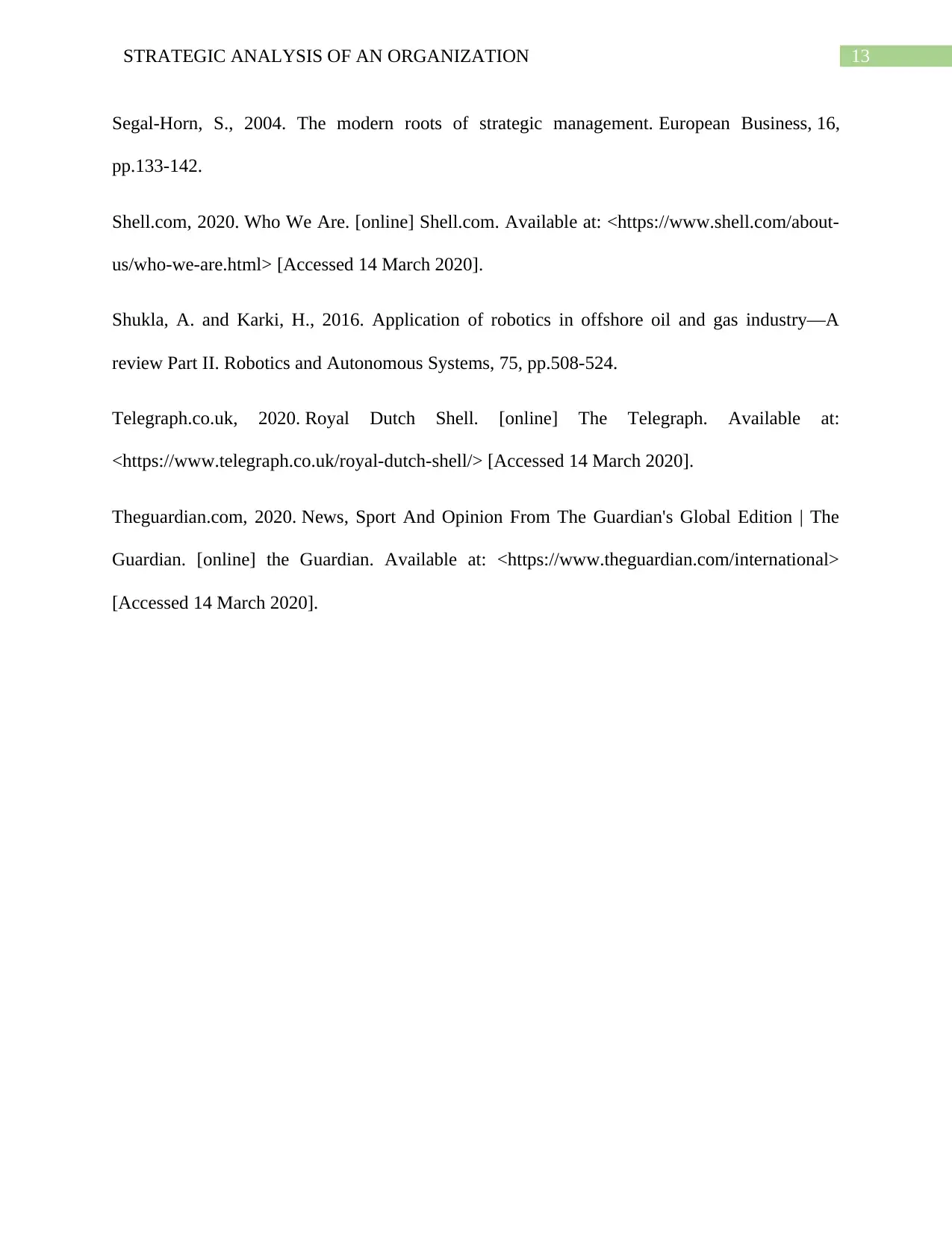
13STRATEGIC ANALYSIS OF AN ORGANIZATION
Segal-Horn, S., 2004. The modern roots of strategic management. European Business, 16,
pp.133-142.
Shell.com, 2020. Who We Are. [online] Shell.com. Available at: <https://www.shell.com/about-
us/who-we-are.html> [Accessed 14 March 2020].
Shukla, A. and Karki, H., 2016. Application of robotics in offshore oil and gas industry—A
review Part II. Robotics and Autonomous Systems, 75, pp.508-524.
Telegraph.co.uk, 2020. Royal Dutch Shell. [online] The Telegraph. Available at:
<https://www.telegraph.co.uk/royal-dutch-shell/> [Accessed 14 March 2020].
Theguardian.com, 2020. News, Sport And Opinion From The Guardian's Global Edition | The
Guardian. [online] the Guardian. Available at: <https://www.theguardian.com/international>
[Accessed 14 March 2020].
Segal-Horn, S., 2004. The modern roots of strategic management. European Business, 16,
pp.133-142.
Shell.com, 2020. Who We Are. [online] Shell.com. Available at: <https://www.shell.com/about-
us/who-we-are.html> [Accessed 14 March 2020].
Shukla, A. and Karki, H., 2016. Application of robotics in offshore oil and gas industry—A
review Part II. Robotics and Autonomous Systems, 75, pp.508-524.
Telegraph.co.uk, 2020. Royal Dutch Shell. [online] The Telegraph. Available at:
<https://www.telegraph.co.uk/royal-dutch-shell/> [Accessed 14 March 2020].
Theguardian.com, 2020. News, Sport And Opinion From The Guardian's Global Edition | The
Guardian. [online] the Guardian. Available at: <https://www.theguardian.com/international>
[Accessed 14 March 2020].
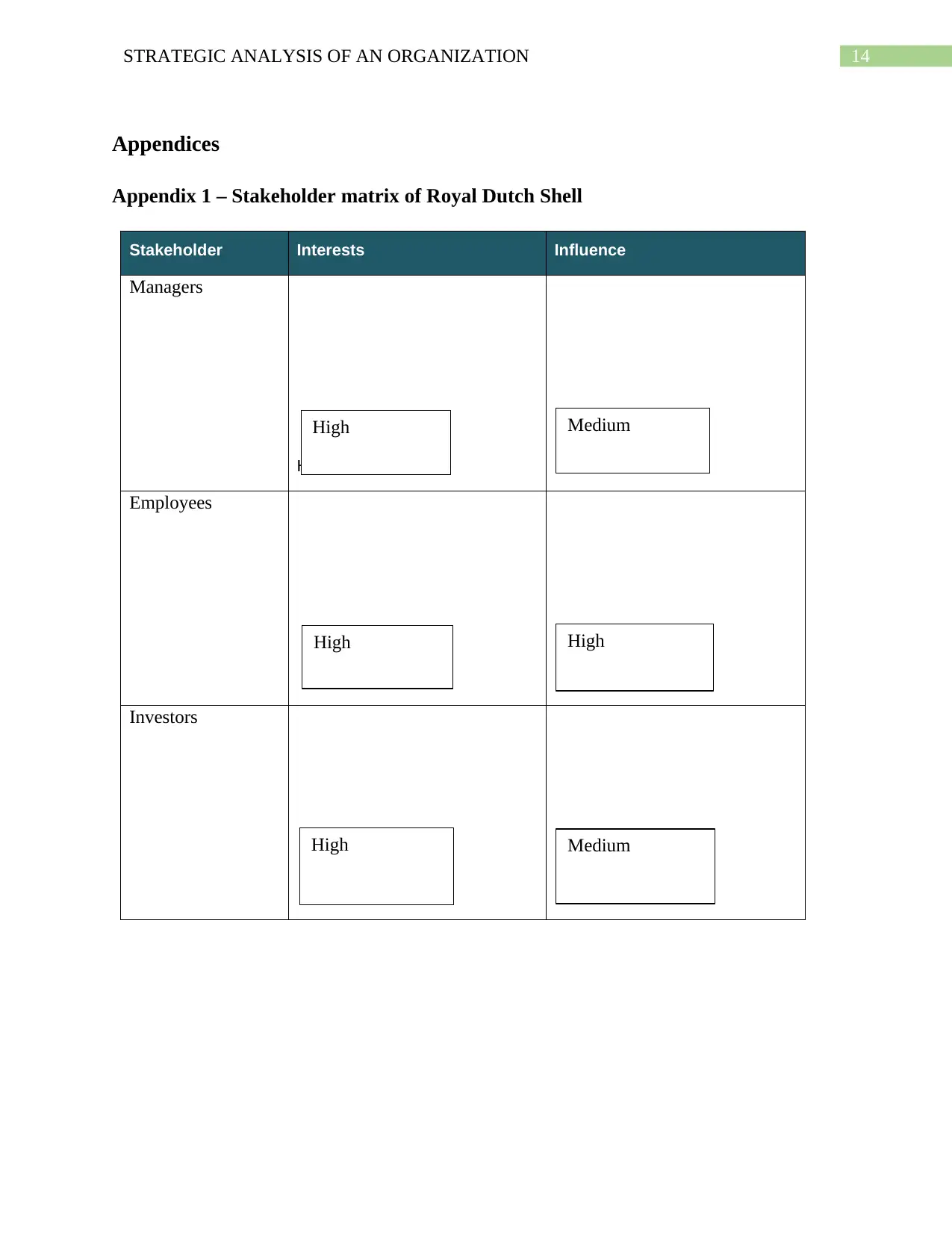
14STRATEGIC ANALYSIS OF AN ORGANIZATION
Appendices
Appendix 1 – Stakeholder matrix of Royal Dutch Shell
Stakeholder Interests Influence
Managers
Hifgh
Employees
Investors
High Medium
High High
High Medium
Appendices
Appendix 1 – Stakeholder matrix of Royal Dutch Shell
Stakeholder Interests Influence
Managers
Hifgh
Employees
Investors
High Medium
High High
High Medium
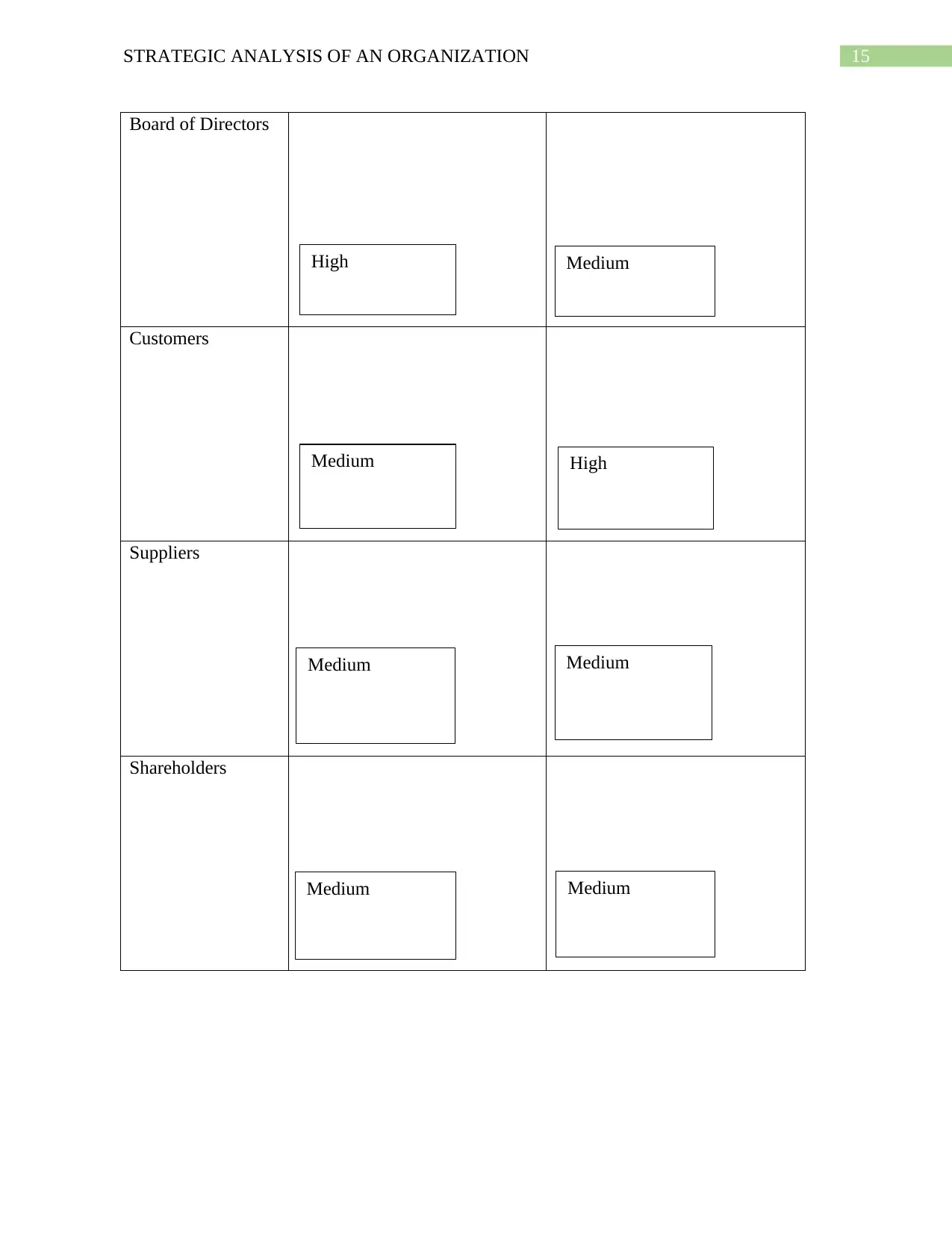
15STRATEGIC ANALYSIS OF AN ORGANIZATION
Board of Directors
Customers
Suppliers
Shareholders
High Medium
Medium High
Medium Medium
Medium Medium
Board of Directors
Customers
Suppliers
Shareholders
High Medium
Medium High
Medium Medium
Medium Medium
Secure Best Marks with AI Grader
Need help grading? Try our AI Grader for instant feedback on your assignments.
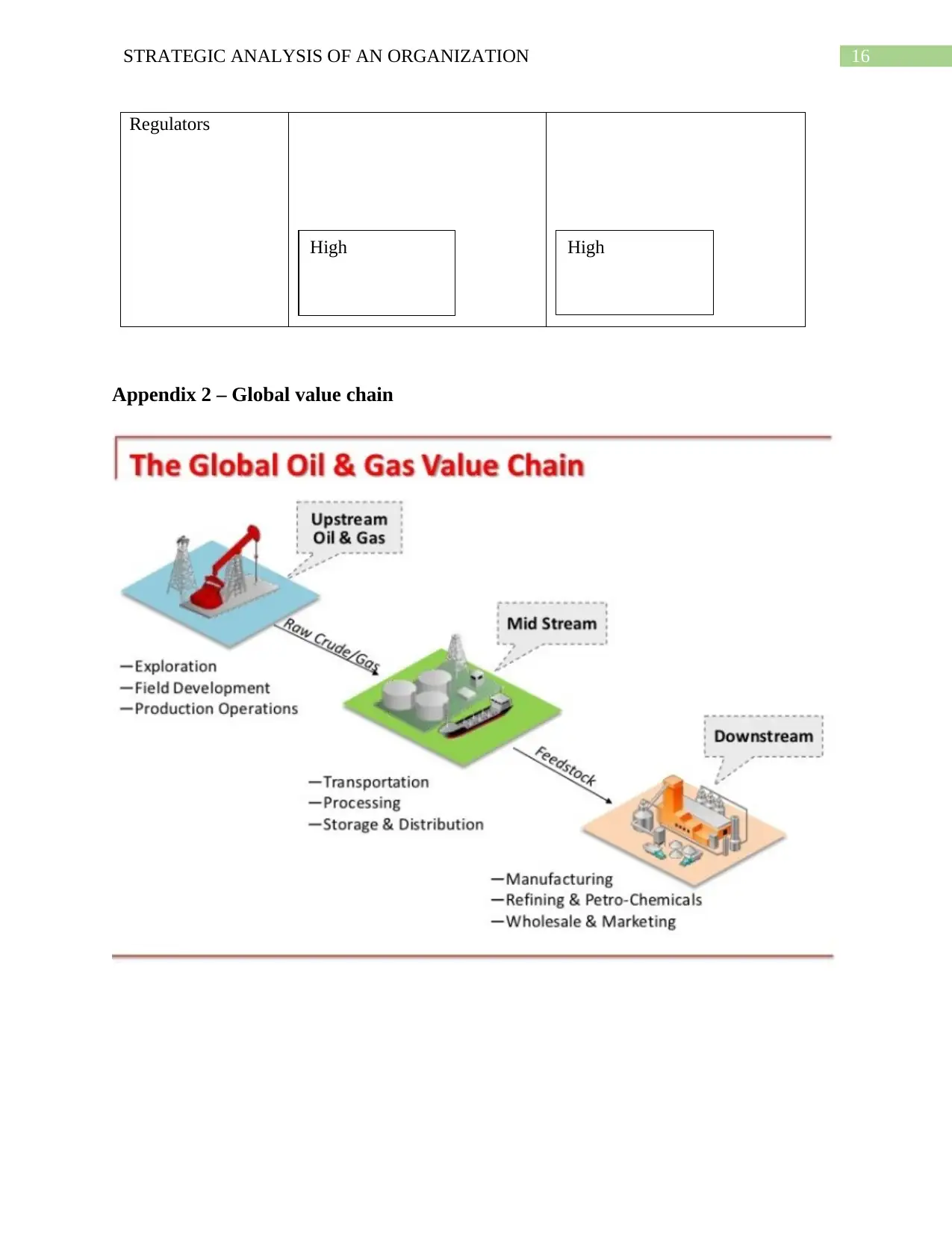
16STRATEGIC ANALYSIS OF AN ORGANIZATION
Regulators
Appendix 2 – Global value chain
High High
Regulators
Appendix 2 – Global value chain
High High
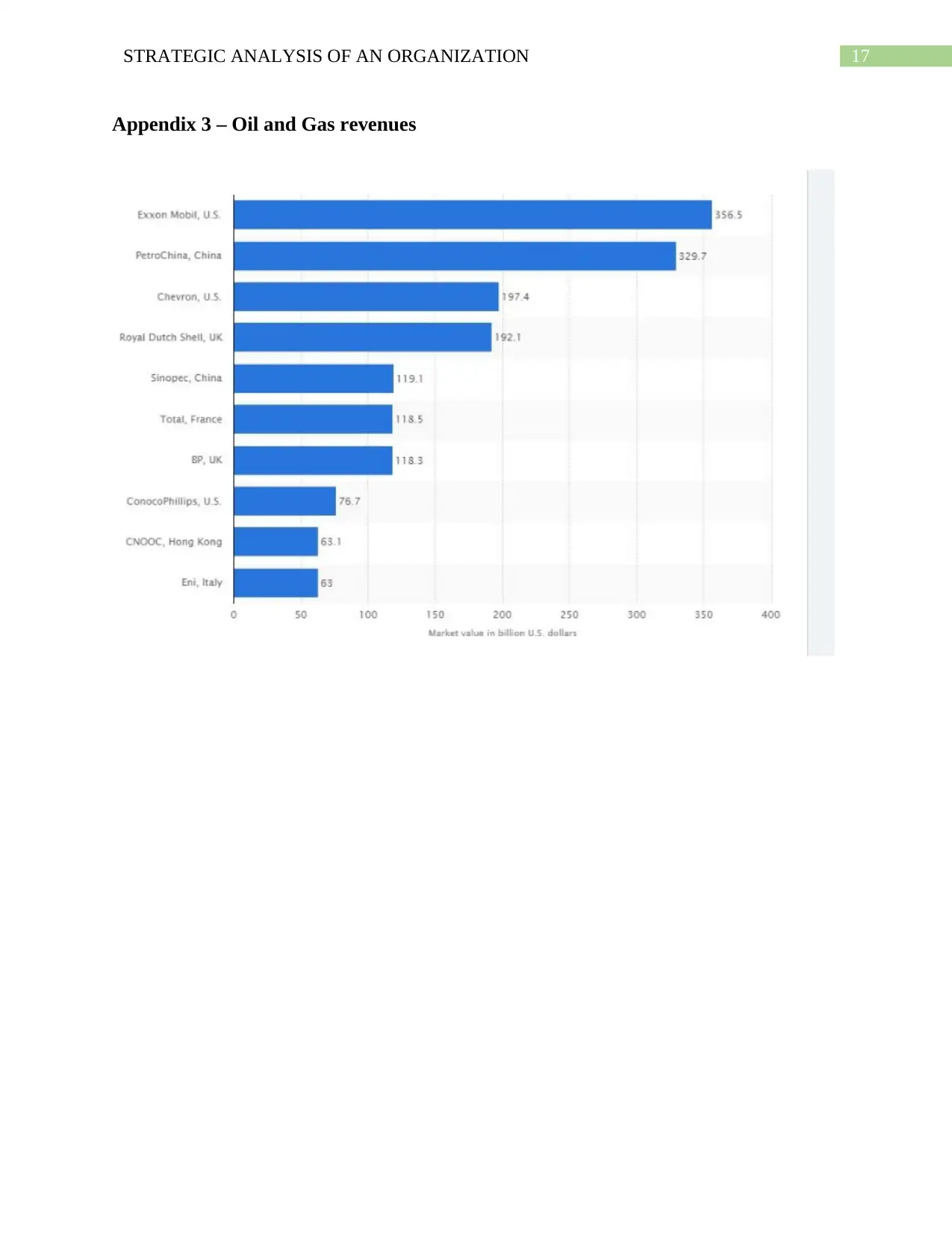
17STRATEGIC ANALYSIS OF AN ORGANIZATION
Appendix 3 – Oil and Gas revenues
Appendix 3 – Oil and Gas revenues
1 out of 18
Related Documents
Your All-in-One AI-Powered Toolkit for Academic Success.
+13062052269
info@desklib.com
Available 24*7 on WhatsApp / Email
![[object Object]](/_next/static/media/star-bottom.7253800d.svg)
Unlock your academic potential
© 2024 | Zucol Services PVT LTD | All rights reserved.





